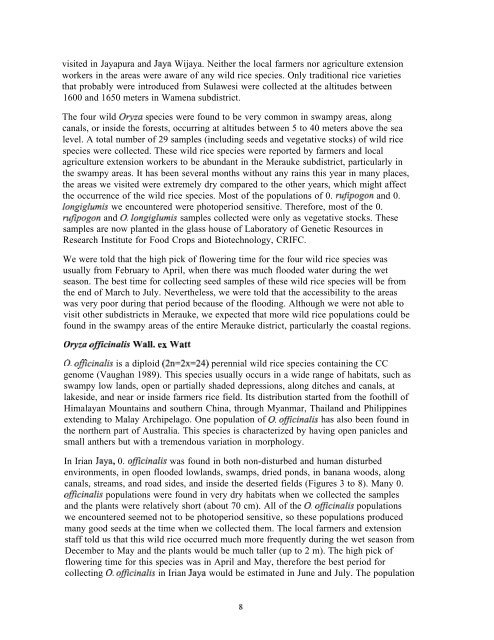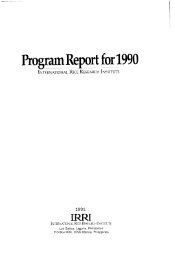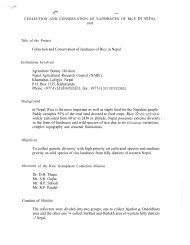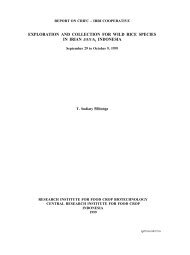Appendix 1 - IRRI
Appendix 1 - IRRI
Appendix 1 - IRRI
Create successful ePaper yourself
Turn your PDF publications into a flip-book with our unique Google optimized e-Paper software.
visited in Jayapura and Jaya Wijaya. Neither the local farmers nor agriculture extension<br />
workers in the areas were aware of any wild rice species. Only traditional rice varieties<br />
that probably were introduced from Sulawesi were collected at the altitudes between<br />
1600 and 1650 meters in Wamena subdistrict.<br />
The four wild Oryza species were found to be very common in swampy areas, along<br />
canals, or inside the forests, occurring at altitudes between 5 to 40 meters above the sea<br />
level. A total number of 29 samples (including seeds and vegetative stocks) of wild rice<br />
species were collected. These wild rice species were reported by farmers and local<br />
agriculture extension workers to be abundant in the Merauke subdistrict, particularly in<br />
the swampy areas. It has been several months without any rains this year in many places,<br />
the areas we visited were extremely dry compared to the other years, which might affect<br />
the occurrence of the wild rice species. Most of the populations of 0. rufipogon and 0.<br />
Zongiglumis we encountered were photoperiod sensitive. Therefore, most of the 0.<br />
rufipogon and 0. Zongiglumis samples collected were only as vegetative stocks. These<br />
samples are now planted in the glass house of Laboratory of Genetic Resources in<br />
Research Institute for Food Crops and Biotechnology, CRIFC.<br />
We were told that the high pick of flowering time for the four wild rice species was<br />
usually from February to April, when there was much flooded water during the wet<br />
season. The best time for collecting seed samples of these wild rice species will be from<br />
the end of March to July. Nevertheless, we were told that the accessibility to the areas<br />
was very poor during that period because of the flooding. Although we were not able to<br />
visit other subdistricts in Merauke, we expected that more wild rice populations could be<br />
found in the swampy areas of the entire Merauke district, particularly the coastal regions.<br />
Oryza offlcinalis Wall. ex Watt<br />
0. officinalis is a diploid (2n=2x=24) perennial wild rice species containing the CC<br />
genome (Vaughan 1989). This species usually occurs in a wide range of habitats, such as<br />
swampy low lands, open or partially shaded depressions, along ditches and canals, at<br />
lakeside, and near or inside farmers rice field. Its distribution started from the foothill of<br />
Himalayan Mountains and southern China, through Myanmar, Thailand and Philippines<br />
extending to Malay Archipelago. One population of 0. ofjcinalis has also been found in<br />
the northern part of Australia. This species is characterized by having open panicles and<br />
small anthers but with a tremendous variation in morphology.<br />
In Irian Jaya, 0. officinalis was found in both non-disturbed and human disturbed<br />
environments, in open flooded lowlands, swamps, dried ponds, in banana woods, along<br />
canals, streams, and road sides, and inside the deserted fields (Figures 3 to 8). Many 0.<br />
ofJicinaZis populations were found in very dry habitats when we collected the samples<br />
and the plants were relatively short (about 70 cm). All of the 0. ofJicinaZis populations<br />
we encountered seemed not to be photoperiod sensitive, so these populations produced<br />
many good seeds at the time when we collected them. The local farmers and extension<br />
staff told us that this wild rice occurred much more frequently during the wet season from<br />
December to May and the plants would be much taller (up to 2 m). The high pick of<br />
flowering time for this species was in April and May, therefore the best period for<br />
collecting 0. officinalis in Irian Jaya would be estimated in June and July. The population<br />
8





